I bought my Pilot VP in Gun Metal Gray, with a Broad nib, for $125. Unfortunately, the sale on Amazon is over but they still have decent prices (starting at $129.95 as of this writing) on certain combinations for these pens so if my review sways you to buy one, you can do me a kindness by following the affiliate link on Amazon to the Pilot Vanishing Point
Some may dislike the Gun Metal Gray combo but the reason I bought it in this configuration is because it's probably the safest one you can get. I would have preferred the Matte Black but I heard many stories that the finish likes to come off after a while. Gun Metal Gray is unassuming and pretty stealthy so it won't attract much attention if I decide to take it out in public. And my goodness how these pens are made just for taking out in public!
As for the nib, I tend to prefer broad nibs because of the usual reasons: I like to go through inks as quickly as possible so I can change them frequently, and broad nibs usually bring out the characteristics of the ink more, which is useful for my ink reviews.
So was the Pilot Vanishing Point worth all the expense? We shall find out together but the outlook is good.
What is the Pilot Vanishing Point?
For the few of you who still don't know what these pens are, and why they are special, let me give you a quick primer. Essentially they are fountain pens which behave like a click-button ballpoint pen. They don't have a cap. Instead, the nib hides inside the pen's body when not in use, and is extended by means of a click button, in a similar manner to that cheap Bic that costs a dime a dozen.
But what's the advantage of these fountain pens? Doesn't the nib dry out? Well, the biggest advantage (to me at least) is that you can pick up this pen and start writing in one swift movement, without having to go through the motions of removing the cap, storing or posting it, then re-capping when you're done writing. If you are in the habit of taking frequent short notes, this can be a lifesaver. There are no caps to lose and the pen's balance doesn't change in use because there are no removable parts. As for the nib, the ink won't dry because Pilot uses a clever mechanism whereupon a tiny internal door seals the opening when the nib is retracted.
Another side effect of this pen's design is that it can mess with people's brains, especially those who haven't encountered something like it before. But this can also be a curse, because I can almost see the clueless coworker who grabs one of these off your desk without permission, clicks the tip open and then starts jabbing at a page without even realizing that he's holding the nib upside down. I shudder to think.
Who is the Pilot Vanishing Point for?
The Pilot VP is for the discerning, modern fountain pen user. Well, not really. While to me the design and function looks modern, this type of pen has been produced in a slightly different guise for many years (see the Namiki Vanishing Point). There are even several different modern pens with a "vanishing point" or "capless" design, such as Pilot's own Fermo (roughly double the price of the VP) and even one that Lamy produced until recently (can't recall the name, sorry).
It's safe to say that if you are functioning in a dynamic environment, where you need to take notes at a moment's notice, and you like a more upscale fountain pen, this might be the instrument for you.
Packaging
For the money, I'm a bit underwhelmed by the packaging but on the other hand I'd prefer if it were even more basic, with the difference in cost rolled into the price of the pen. In truth, unless the pen costs hundreds or thousands of dollars, you most likely won't want to display it proudly anyway.
First, there's a sliding external cardboard box, which is elegant but simple. I really like the modern embossed design on it.
Underneath is the actual box in which the Pilot Vanishing Point rests. This is a display-type snap-case with a faux leather finish. It's probably made out of cardboard.
You might notice some dust on the window. This pen must have been kept in storage for a long time because that's how I received it and the dust was nigh impossible to wipe off, perhaps due to the window being plastic.
Once you snap the case open, the beautiful Vanishing Point is revealed in its soft bed. Well, it was already revealed but you get the point.
You'll notice the tag which says "Pilot Capless Broad Japan". The words "Vanishing Point" do appear on the UPC tag on the external box, as well as in the instruction manual, but not on this tag.
If you lift the insert by the silk ribbon you'll find more goodies hidden underneath. These include an instruction manual, a warranty card, but more importantly the CON-50 piston converter, a spare blue ink cartridge, and a blind cap for the cartridge. The Vanishing Point has a 3-year warranty and I'm actually going to mail in the warranty card, not because I'm afraid of anything going wrong but because it feels right to do so.
In the above photo I have already loaded the included ink cartridge. I could have gone with any of the inks in my collection but I thought it might be fitting to test it for the first time with Pilot/Namiki's own ink.
So the packaging is okay but not amazing. As a side-note, I really liked the neat box my Lamy AL-Star came in. Very simple and functional. Here are some beautiful pictures of the Lamy Safari's packaging on FPGeeks' website.
Body, construction, and dimensions
This gorgeous silver torpedo is rather thick, especially around the midsection, and then tapers at both ends. It really looks like a torpedo. Here it is compared to some of my other pens (TWSBI Diamond 530, Lamy AL-Star, Noodler's Ahab, Pilot Prera):
The length is 5.5 inches (14cm), and that's about the same as a capped Lamy Safari/AL-Star or Noodler's Ahab. Maximum thickness is about 0.5 inch (1.27cm), comparable to a TWSBI 530/540/580 or a Noodler's Ahab.
Here are the weights compared for the pens in the above image:
Pilot Vanishing Point (with cartridge and blind cap) - 30.5g - 1.08oz
TWSBI 530 (no ink) - 25.7g - 0.91oz
Lamy AL-Star (with converter) - 21.8g - 0.77oz
Noodler's Ahab (no ink) - 18.8g - 0.66oz
Pilot Prera (with converter) - 16.1g - 0.56oz
As you can see, it is weightier than all of these pens, and you can feel it. You are really holding a large chunk of metal. In fairness, the other pens aren't metal, except for the Lamy which is aluminum, but the VP is made of a denser metal.
The Pilot Vanishing Point may not appeal to everybody due to the peculiarity that it has the clip at the nib end, as opposed to the butt end where most pens have it. But that, of course, is because it lacks a cap. Still, don't ballpoint pens have the clip at the plunger end? Yes, but the VP is a fountain pen and positioning the clip like that ensures the pen will sit with the nib upright when clipped to a shirt pocket. That way there's no risk of ink leaking into your shirt.
The position of the clip may render the pen uncomfortable for some, but don't knock it until you try it. I took a calculated risk when buying this pen and it paid off. The clip position doesn't intrude at all, in fact it helps me hold the pen with the nib pointed in the right direction. I can basically grab it from the table, click it open and start writing without glancing at the tip to see if it is aligned properly.
The clip is spring-loaded, with medium stiffness. I haven't actually clipped it to a shirt pocket because it's still sitting on my home office desk.
The barrel is made of two sections, one containing the plunger, the other containing the nib end and the clip. While the body is metal, the Gun Metal Gray finish is not the bare metal. It is glossy and resembles some sort of lacquer. The black trimmings are painted matte, with the exception of the two gloss black rings which join the sections.
One of the cool things about the Pilot VP is the nib unit itself. It is like a miniature self-contained fountain pen (without the cap) which resides inside a larger pen, like a set of Russian dolls.
If you wish, you can simply grab the nib unit and start using it like a fountain pen. It's just that you might find it rather thin. The big advantage is that you can dip the nib (which is longer than the average nib) into an ink bottle and avoid getting the rest of the pen (section, barrel, etc) dirty. The nib unit fits inside the pen body one way only, constrained by the notch shown below. This ensures it is aligned properly with the exit hole.
Operation
The Pilot Vanishing Point is operated via the plunger, like any ballpoint pen. Notice how long the plunger is. That's most likely because the nib needs to extend farther than a ballpoint tip.
As you press the plunger, a small gate - acting as an internal cap which seals the nib - retracts, just as the nib pushes past it. Here's how the process looks.
This mechanism is incredibly smooth, unobtrusive and efficient. My pen hasn't dried one bit since I got it a few weeks ago, despite not getting a lot of use.
The plunger rattles a little when active but it's barely noticeable.
A closer look at the nib
The nib in the Pilot Vanishing Point is much narrower, but also longer, than a regular nib. Mine is a Broad and apparently it is 18k gold, whatever that means. It's probably gold plated because I doubt it's solid gold at this price. Someone correct me if I'm wrong.
Here's how the nib and the feed look when extended.
I can understand people who dislike the appearance. If you give it too much thought it does look like an ugly little thing. I prefer too see it as a very fancy ballpoint/rollerball tip instead.
Here it is compared to the broad nibs in the TWSBI Diamond 530 and Kaweco Sport Classic.
And again compared only to the TWSBI 530.
Notice that the size of the tipping for all three nibs is pretty much identical. And so is the line they produce, though each pen has its unique personality.
One thing worth mentioning is that the nib never dried up on me when exposed, not even during several prolonged photo sessions. I've never quite encountered this in other nibs. I don't know if there's a special trick that Pilot employs or it's just happenstance.
But does it write?
It writes, and well it does. This is one of the smoothest broad nibs I've used, even slightly more so than the TWSBI 530's, which is a superlative nib in itself.
On paper it glides like a hot knife through butter (pardon the oft-used metaphor). Any paper. The sample above is Clairefontaine 90g, but cheap copy paper doesn't phase this nib at all. On both papers it almost feels like there's an air cushion between the surface and the nib.
To be honest, I was expecting this Japanese broad nib to be more like a European medium. I was wrong. The line is just as wide as the TWSBI's and Kaweco's German nibs. The VP nib is, however, slightly smoother than the TWSBI and a lot more than the Kaweco. It turns out that Japanese broad nibs aren't very different from other broads after all.
You might be curious about the springiness of this nib and I can tell you that it likes to flex a little. It's obviously not a flex nib but it is far from a stiff nail. In fact, the springiness allows it to imbue some extra line variation if a little pressure is applied. Check out this poor quality Instagram shot that I took while typing this paragraph.
Flow can always be a deal-breaker but this is certainly not the case here. The unit supplies the nib with plenty of ink, in a very controlled manner. I've never encountered a hard start or any skipping whatsoever. When I click it, it's ready to go. I feel supremely confident that it won't spit ink but at the same time it will lay a nice, fat, wet line, just the way I like it. On the other hand, cheap paper does not a great partner make, as it likes to suck in all that extra ink like a sponge.
While I like the nib and would buy it all over again if I had the chance, I'm already thinking about potentially acquiring a medium nib unit to complement this one. I like broad nibs because they go through inks quickly and show off the ink shading nicely, but for journaling or more official note-taking, a thinner nib might be more appropriate. Besides, it might be fun to keep different inks in each nib unit and swap them when the need arises, though I would have to figure out how to store and keep them from drying.
A quick word about Pilot's ink
While I'm usually quick to dismiss the ink cartridges that are sometimes included with fountain pens, I have to admit that Pilot/Namiki's blue ink is quite excellent. Not only is it a pleasant, saturated blue, but it actually features some very decent shading, which allows the broad nib in the VP to shine even more. Here are two close-ups of the writing sample.
Of course, you would expect such an ink to work perfectly with the pen it accompanies, and perhaps that's partly why the pen writes so smoothly. On second thoughts, that might also be a reason why it doesn't dry out when the nib is exposed for such a long time. Either way, I'm very pleased with the blue Pilot ink cartridge. In the end, I still can't wait to finish it so I can try other inks in this pen.
Final words
The Pilot Vanishing Point is my most expensive fountain pen to date, and though it took some courage to buy it, I am very glad I did. I don't regret the choice of the broad nib either. The Vanishing Point is so different than any other pen I own, but its design makes it more practical and durable than all the others. It is stealthy, yet recognizable. The build and mechanism are tuned with Japanese precision. The nib, oh boy is it smooth! And it flows so well that it makes me forget all the hard starts and skipping issues I had with lesser pens.
In short, I feel that this freshly kindled love for the Pilot Vanishing Point will burn bright for many years. But aren't there any negatives, you might ask? None whatsoever. But then love is blind and I'm just a little biased.



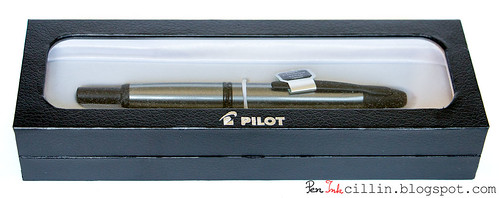
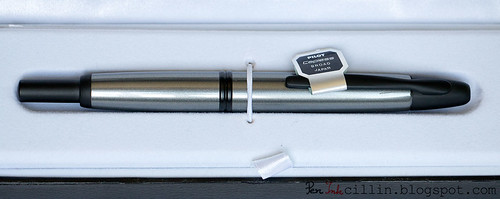


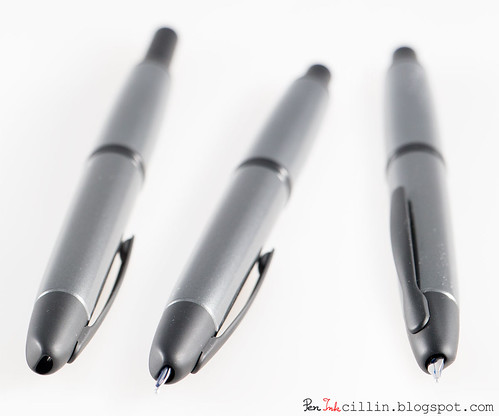


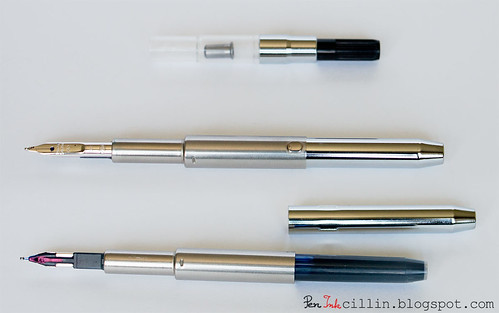
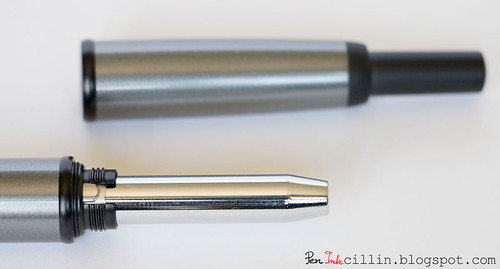


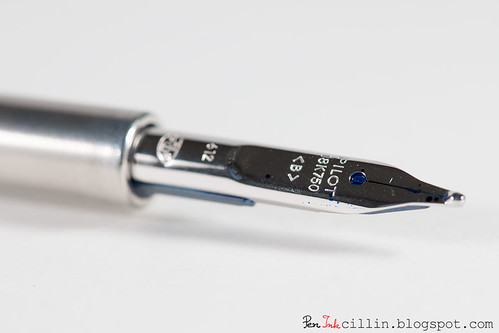

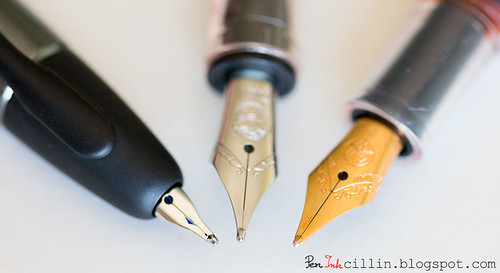

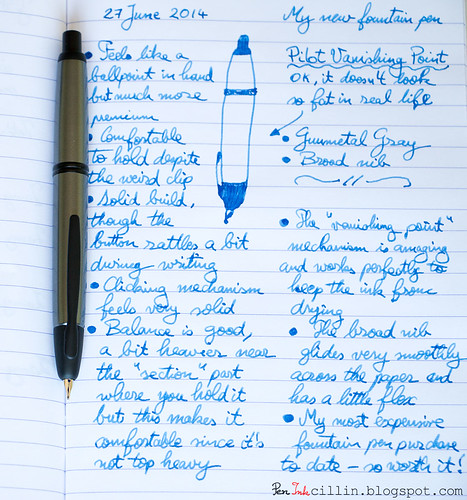
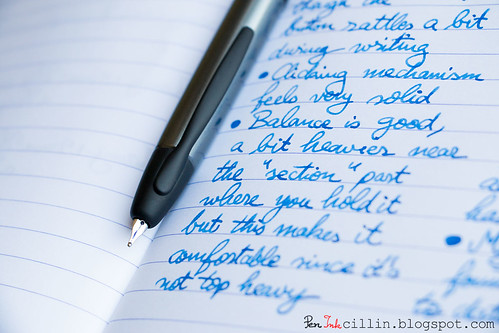
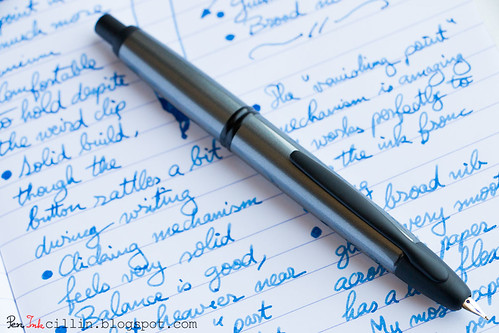
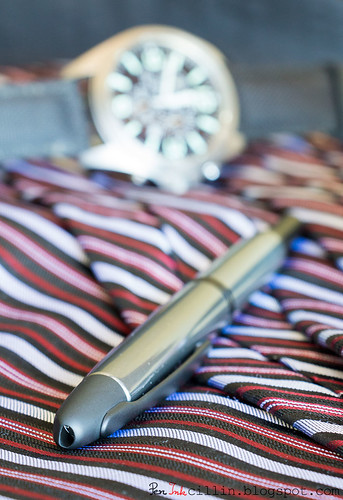
The VP is one of my favorite pens and I definitely plan to always keep one in the collection. I do second buying a M nib for it - I had a broad and it turned me off the whole pen initially (even though I now love big fat nibs) but the medium just complements the on-the-go, write anywhere nature of the pen.
ReplyDeleteI completely agree. The medium nib would make it a true jack-of-all-trades. But the broad is a sweetheart on its own. I'm in no rush to get a medium since I plan to use this pen for ink reviews, at least until I run out of ink samples.
ReplyDeleteThis is a pen that is on my Wishlist to get someday. It would not be the most expensive one though. I am looking at the Platinum 3776 "Nice" fountain pen that is due to come out sometime this month. $200 at Goulet Pens! Hopefully one day I may get the opportunity to have both.
ReplyDeleteNice review, thanks. I'm a fan of the Vanishing Points. Although I don't personally like broad nibs your review tracks with my thoughts on the pen. I have several VP nibs and all have been great. Enjoy the pen!
ReplyDeleteI have an older Namiki Vanishing Point (medium nib) and everything you write about the current iteration holds true for the older model. I would love to get one in the Desert Orange or Copper Red metal version with a fine nib. It is definitely on my wish list. :-)
ReplyDeleteGreat review. I own the stealth black version which I really like but can't say I have banged it around enough to lose any of the finish. I did spring for a binderized nib unit in Medium and it writes wonderfully. I love the engineering and attention to detail they gave it.
ReplyDeleteWell, I guess you already have the courage to spend >$100, now it's just a matter of timing. The "Nice" is nice, though it has a weird name, but you should definitely plan for a VP at some point.
ReplyDeleteThanks! Which nibs do you have and how would you rank them?
ReplyDeleteI think the VP has the potential to be a sort of Japanese Lamy Safari. It has so many cool colors... I would have loved the yellow one with silver trim but that one just screams for attention.
ReplyDeleteThanks! I might have read somewhere that they fixed the black finish issues, but can't be sure. These customized grinds sure are tempting but they raise the bar too much for someone like me who's reluctant to invest a lot of money in pens.
ReplyDeleteThere is also a Raden version of VP (actually three versions) and it looks absolutely gorgeous! Although the price is also absolutely "gorgeous" as well...
ReplyDeleteMy Binderized nib is a smooth medium, nothing fancy but if you would like to try it to experience the difference drop me an email and I'll send it over for a test drive. bob@mypenneedsink.com
ReplyDeleteHoleee price Batman! That's something I'm guaranteed not to touch - ever. Unless someone gives it to me. On the other hand I'm really starting to dig the black with gold accents. It looks very classy and dignified.
ReplyDeleteOh, that "Nice"! Haha, never thought it might refer to that. Thanks for clearing that up.
ReplyDeleteAnd glad to know that it's an actual gold nib. Thanks again!
I got one of the darker yellow Pilot VP with a fine nib and it's become my daily use pen at work. I have a collection of off-brand sticky notes on my desk most of the time and even on that cheap paper it never gives me any problems. The quick pick-up-and-go and always-ready reliability of the VP pens has got me hooked. I've got a black with silver accents and a medium nib (and yes, swapping the bodies is a great way to change things up when a less bright and in-your-face pen colour is needed. I would without hesitation recommend these durable, efficient, and fun pens for anyone looking to spend a little extra cash on a special pen for their collection.
ReplyDeleteI really like the yellow one with silver trim. Was tempted to get one but eventually decided to go with the gun metal gray for stealth.
ReplyDeleteI received the yellow one with silver trim as a Christmas gift, from someone who must love me very much! :)
ReplyDeleteI love it and it has become a daily writer for me. I also think the yellow screams for attention, but honestly, I've not had one person ask me about it or make any remarks. A few curious side glances is all it has garnered so far.
Ironically, I use my VP at home exclusively, so in the end it doesn't matter what color it is. Should have bought the yellow one :)
ReplyDelete